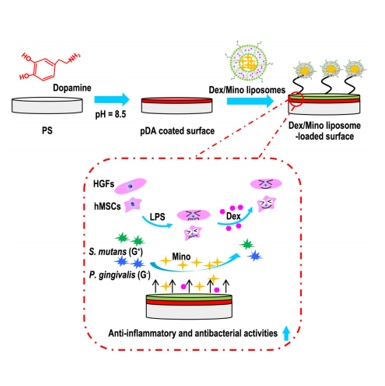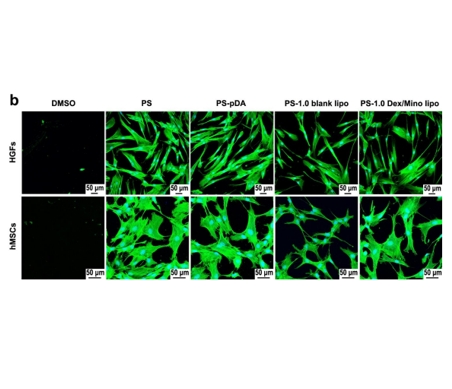文献:Facile and Versatile Strategy for Construction of Anti-Inflammatory and Antibacterial Surfaces with Polydopamine-Mediated Liposomes Releasing Dexamethasone and Minocycline for Potential Implants Applications
文献链接:
https://pubs.acs.org/doi/10.1021/acsami.7b06295作者:Xiao Xu, Lixin Wang, Zuyuan Luo, Yaofeng Ni, Haitao Sun,Xiang Gao, Yongliang Li, Siqi Zhang, Yan Li, and Shicheng Wei
原文摘要:
Reducing early nonbacterial inflammation induced by implanted materials and infection resulting from bacterial contamination around the implant-abutment interface could greatly decrease implant failure rates, which would be of clinical significance. In this work, we presented a facile and versatile strategy for the construction of anti-inflammatory and antibacterial surfaces. Briefly, the surfaces of polystyrene (PS) culture plates were first coated with polydopamine and then decorated with dexamethasone plus minocycline-loaded liposomes (Dex/Mino liposomes), which was validated by contact angle goniometry, quartz crystal microbalance, and fluorescence microscopy. Dex/Mino liposomes were dispersed on functional surfaces and the drug release kinetics exhibited the sustained release of dexamethasone and minocycline. Our results demonstrated that the Dex/Mino liposome-modified surfaces had good biocompatibility. Additionally, liposomal dexamethasone reduced proinflammatory mediator expression (particularly IL-6 and TNF-α) in lipopolysaccharide-stimulated human gingival fibroblasts (HGFs) and human mesenchymal stem cells (hMSCs). Moreover, liposomal minocycline prevented the adhesion and proliferation of Porphyromonas gingivalis(Gram-negative bacteria) and Streptococcus mutans (Gram-positive bacteria). These findings demonstrate that an anti-inflammatory and antibacterial surface was developed, using dopamine as a medium and combining a liposomal delivery device, which has potential for use to reduce implant failure rates. Accordingly, the surface modification strategy presented could be useful in biofunctionalization of implant materials.
DSPE是一种饱和的18C磷脂,具有两个硬脂酰基团,赋予DSPE-PEG-NH2疏水性,有助于其与细胞膜或其他疏水性物质结合。PEG(聚乙二醇):作为亲水性高分子聚合物,PEG的引入增加了DSPE-PEG-NH2的水溶性和生物相容性,使其更适用于生物医学应用。NH2(氨基):一种碱性官能团,具有亲电性,可以与其他化合物中的酸性官能团发生反应,形成胺键。因此,该文献利用NH2基团赋予了DSPE-PEG-NH2一定的反应性和物理化学性质改变的能力,使其可用于进一步的官能化反应和功能化修饰,合成流程如下:

图:流程示意图
PS - pDA 表面的预处理:
首先,需要对 PS - pDA 表面进行清洗和活化。可以使用适当的溶剂(如乙醇、水等)对其进行超声清洗,以去除表面的杂质和未牢固吸附的物质。然后,将清洗后的 PS - pDA 样品置于适当的缓冲溶液中,使其表面充分水化,为后续反应提供一个良好的水环境。
DSPE - PEG - NH₂与 PS - pDA 表面的连接:
将 DSPE - PEG - NH₂溶解在适当的有机溶剂(如氯仿或二甲基亚砜)和缓冲溶液的混合溶液中,制成一定浓度的溶液。将 PS - pDA 样品浸泡在上述溶液中,在一定的温度下反应一段时间。在这个过程中,DSPE - PEG - NH₂分子中的 NH₂官能团会与 PS - pDA 表面的活性基团(如多巴胺残基上的氨基、酚羟基等)通过共价键(如席夫碱反应、迈克尔加成反应等)或非共价键(如氢键、静电作用)相结合,从而使 DSPE - PEG - NH₂覆盖在 PS - pDA 表面。
氧化邻苯二酚的包裹:
制备氧化邻苯二酚溶液。将氧化邻苯二酚溶解在适当的溶剂(如乙醇、水或其混合溶液)中,制成合适浓度的溶液。将已经连接了 DSPE - PEG - NH₂的 PS - pDA 样品浸泡在氧化邻苯二酚溶液中,在适宜的条件下进行反应。由于 DSPE - PEG - NH₂覆盖层上的活性基团(如 PEG 链上的羟基等)和氧化邻苯二酚的活性基团(酚羟基等)之间可以相互作用,氧化邻苯二酚会逐渐包裹在 PS - pDA 表面。反应温度可以为室温至较高温度,反应时间可能需要数小时至数天,具体取决于反应条件和所需的包裹程度。在反应过程中,可以通过搅拌或振荡等方式来促进氧化邻苯二酚的均匀包裹。

图:对比图像
结论:
结果证明,经DSPE-PEG-NH2修饰的脂质体表面具有良好的生物相容性。研究表明,使用多巴胺作为培养基,并结合脂质体传递装置,开发了一种消炎和抗菌的表面,这有可能用于降低植入失败率。因此,所提出的表面修饰策略可用于植入物材料的生物功能化。

 2024-12-18 作者:ws 来源:
2024-12-18 作者:ws 来源:

